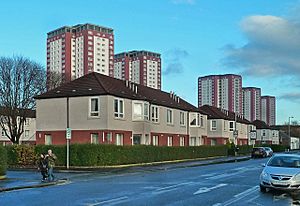Royston, Glasgow facts for kids
Quick facts for kids Royston |
|
|---|---|
 Houses and tower blocks off Royston Road |
|
| OS grid reference | NS604663 |
| Council area | |
| Lieutenancy area |
|
| Country | Scotland |
| Sovereign state | United Kingdom |
| Post town | GLASGOW |
| Postcode district | G21 2 |
| Dialling code | 0141 |
| Police | Strathclyde |
| Fire | Strathclyde |
| Ambulance | Scottish |
| EU Parliament | Scotland |
| UK Parliament |
|
| Scottish Parliament | |
Royston/Roystonhill is a district in the city of Glasgow, Scotland. It was previously known as The Garngad and is still known as such by residents with a familial link to the area. It is notable for its large population of immigrants, mostly of Irish Catholic descent, with an annual St Patrick's Day Festival.
The district is situated north of the River Clyde and north-east of Glasgow city centre, with its boundaries defined by infrastructure: the neighbourhoods of Sighthill (once the site of the St Rollox Chemical Works) and Townhead are to the west on the opposite side of the A803 road, a dual carriageway urban bypass; Springburn is to the north beyond the sidings and buildings of the former St Rollox railway works and a supermarket built on part of its good depot; Germiston and the Blochairn industrial area are situated to the east on the other side of the North Clyde Line (Springburn branch) railway line; and Dennistoun is to the south on the opposite side of the M8 motorway. Pedestrian footpaths provide access over the roads to Dennistoun and Sighthill, and under their meeting point at the Townhead Interchange towards Glasgow Royal Infirmary. The railway lines once included stations named St Rollox to the north and Garngad to the east, but there are now none serving the area.
There are few vestiges of the old Roystonhill in evidence these days other than a few street names, some streets having succumbed to development. The church steeple (a listed building, formerly Townhead-Blochairn Church) has been converted into a tower monument and the church hall carries on its service as a local community centre. The former convent has been relocated in the Robroyston area further north. The previous stigma of deprivation earned in its slum years has largely been shed with a recent program of newbuild housing and renovations to social housing (three 1960s tower blocks at Rosemount Street have been demolished, with five others at Charles Street renovated).
The local football team, denominational primary school and secondary school are all named after Saint Roch.
A former Member of Parliament (MP) for the area, Michael Martin, was Speaker of the House of Commons from 2000 to 2009. During his tenure, the UK parliamentary expenses scandal occurred.
The social club for Catholic community was traditionally known as the 'Hibs Hall'. The Hall was sold by the Ancient Order of Hibernians in 1969 to St. Roch's RC Parish before being sold to a local private concern and renamed "The Huddle Club". The club was burnt down in a fire in the early 21st century.
Royston was the venue for street parties celebrating Celtic F.C. League wins in 1998 and 2001. The first street party was a semi-planned, semi-impromptu gathering along the Royston Road which became the inspiration for the second street party. The street party of 2001 was much more professionally planned and included a stage with live music as well as murals being painted and a video produced to mark the event. There was controversy surrounding this event as the council has never arranged or permitted any such event for Celtic's rivals, Rangers F.C. from across the River Clyde.
Notable residents
- Stevie Chalmers, footballer
- Louie Deadlife, rapper
- Jim Forrest, footballer
- George Gallacher, singer
- Jimmy McGrory, footballer
- Kevin Rutkiewicz, footballer



